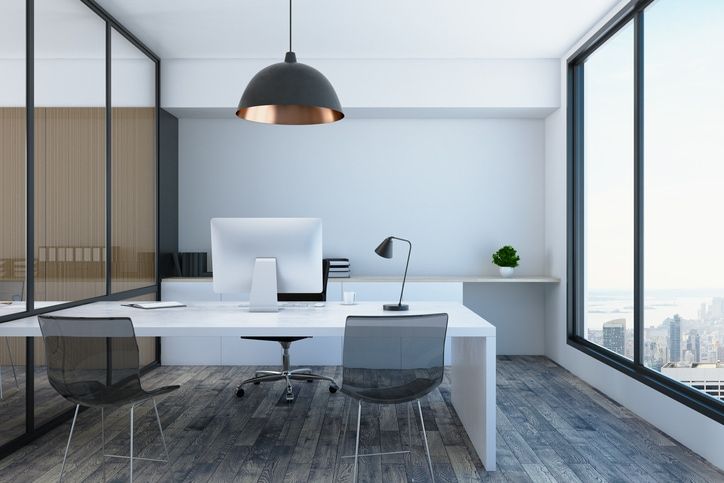
Have you ever considered what is the most productive workspace configuration for your personality or your job duties? Basically, your options are an open office vs closed office space working environment. There are a number of factors that come into play in deciding which scenario is better for you.
This article will delve into the differences of an open office space vs closed office environment, drawbacks and the benefits of closed offices, as well as advantages and disadvantages of open office working configurations. Also, I’ll look at what may be the better option for you based on your working habits, job duties, and your personality.
Open Office vs Closed Office Space
An open office is a working environment which was originally initiated to maximize the number of employees within an open work area. The actual configuration is typically a large table or group of adjoining tables and the employees are seated at the tables side-by-side.
Open office layout ideas evolved in an effort to enhance employee collaboration and, more importantly in my mind, to minimize costs associated with office space real estate.
A closed office is identified as an area which is sectioned off into a combination of individual offices with doors and office cubicles which more often than not would be a separate department within a company.
This has always been considered the traditional type of working environment and one in which I have worked in and continue to work in to this day.
Open Office Space vs Closed Office Comparison Chart
| Criteria | Open Office | Closed Office |
|---|---|---|
| Collaboration | It is perceived that an open office promotes employee collaboration but some evidence indicates otherwise. | Depending on the size of the office employees can meet within the office to collaborate. Even a small cubicle can allow 2-3 employees to interact. |
| Storage | Due to the configuration of an open office with a large desk or adjoining desks, drawers and storage areas are oftentimes in a remote area and not near the individual employee. | A closed office such as an office with a door or even a cubicle, there are on-site desk drawers and overhead bins for storage of employee files, journals, books, and personal items. Hanging file folders and shelves can even be attached to walls for storage. |
| Personalization | Within an open office, the ability to personalize the space is limited or non-existent. | A closed office allows the employee to customize their office desktop, walls, or anywhere else within the workspace. A simple exercise of hanging family pictures on a wall is allowed within a closed office but not possible in an open office environment. |
| Focus | The ability to focus within an open office working environment can be extremely challenging. Utilizing Noise-cancelling headphones or implementing other office noise solutions may help to eliminate extraneous noise. | The ability to focus in a closed office is one of the major benefits of such an environment. |
| Cost | Companies prefer an open office space working environment because it is cheaper to implement and can be done so within a smaller footprint. | Traditional closed offices are more costly to implement for a company but may provide a more personal and productive working environment for employees. |
Open Office Space Pros and Cons
Advantages of Open Office Environment
- Collaboration is perceived to be higher in an open office
- An employee may seem less isolated from coworkers
- Much cheaper to implement open office vs closed office
- May lead to a greater level of camaraderie with employees
- Requires much less real estate to implement an open office
Disadvantages of Open Office Environment
- Employee has no private and separate workspace with walls
- Employee focus is severely hampered
- Virtually no ability to furnish/decorate a workspace
- Personal storage capabilities are limited
- Meetings with coworkers must be moved to a separate walled space
Closed Office Space Pros and Cons
Benefits of Closed Office Spaces
- Employee has a private working area
- Promotes a high sense of ownership of the workspace
- Ability to focus is high
- Ability to decorate space to match personality
- On-site employee storage capabilities
Disadvantages of Closed Office Environment
- If the closed office is a cubicle, it may be perceived as a depressing environment
- A closed office may seem to be separate or distant from coworker interaction
- More expensive for a company to implement vs an open office environment
- A closed office layout takes up much more space than an open office
- Could lead to a less united employee atmosphere
Which Option, Open Office or Closed Office, is Your Better Option?
There are a few factors when it comes to an individual employee that will affect whether or not which option is best for you. Let’s have a look at those factors.
Job Duties
Do you work in an environment where you need to interact with your immediate coworkers on a regular basis? For example, if you are on the phone constantly with customers and need to refer to your coworkers while on the phone then an open office vs closed office space working environment just might be a better option for you.
Work Habits
Are you one who works better if your head is down and you’re concentrating on the task at hand? Are you more productive when you are on your own in your own personal space? This is certainly my ideal working scenario and I work much better if I can focus without any distractions.
If you are like me and exhibit these types of working habits then a close office space environment is probably better for you.
Personality Type
Are you an introvert or an extrovert? If you get your energy from within then you are probably an introvert. If you get your energy from others then you are deemed an extrovert. This is a pretty clear delineation and your working environment can be easily mapped to your personality type.
If you are an introvert, there is no doubt that you tend to work better in a closed office environment. If you are an extrovert you’ll probably be more productive around others which is what is found in an open office working scenario.
Open Office vs Closed Office Space Summary
In today’s workplace, chances are you are working more from home than in the past. But if you are now back in the office you are in one of two working configurations. The choices are open office vs closed office environments.
The drawbacks and benefits of closed office spaces have been addressed in this article as well as the disadvantages and advantages of open office working configurations. Your job duties, working habits, and personality type will identify which scenario will lead to a more productive environment for you.
Bob has been blogging for over 20 years and has been an office and cubicle dweller for more than 35 years. He has been featured in numerous online publications such as US News and World Report, Bustle, and Work Awesome (you can read his articles here). He created the popular office website CubicleBliss in January 2011 and rebranded it as WorkspaceBliss in April 2020.
In the office he’s been an IT Manager, Applications Engineer, Systems Analyst, Software Project leader, and Programmer Analyst in his long career. He’s a Certified Microsoft Professional and possesses a Masters of Science degree and two Bachelor of Science degrees, one of those in Informational Technology.
During his career he has worked in the office full-time, as a hybrid remote worker, and has worked from home permanently.






